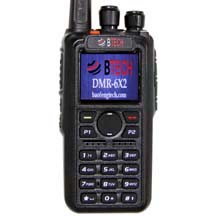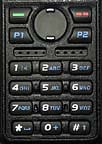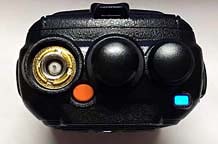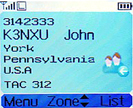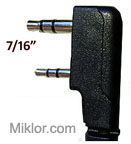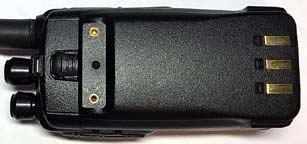|
BTECH DMR-6X2
Several Dual Band DMR handhelds have been introduced into the market in the past few months. Having owned most of them, I would have to place this one toward the very top of the list. The DMR-6X2 is both VHF and UHF, Tier II DMR digital as well as a FM analog with many features geared strictly toward ham radio use. That being said, let’s see what’s… General Description Some of the New 6X2 Features Priority Scan When developing a scan list, up to 2 channels can be assigned as priority. This allows the priority channels to be interwoven in the scan list. As an example: – Channel 1 Change Group via Keypad Especially nice if using a hot spot. By setting a key function to “Dial”, and the Group Call Hold time to “Indefinite”, you can enter a Talk Group using the number pad and it will remain permanently or until the channel is changed. No longer is the hold time set in seconds or minutes. Start up Code Plug To assist with start up, the software was written to initially accept an Anytone D868UV code plug. I’ve had a 868 since they first came out, and this was a huge time saver. Everything transferred and I was ready to play radio in minutes. Digital Simplex Repeat This feature allows the 6X2 to be used as a relay point during events such as marathons, races, etc. where a central relay method is needed and there is no local repeater. More to Come
The frequency range of the DMR-6X2 is both VHF 136-174 and UHF 400-480 MHz. Along with DMR, the radio also supports FM (wideband and narrowband) The power levels hold pretty close to the specifications. There are four power levels with a high of 5.0W and a Turbo mode of 6.5W. I just run mine in 5W mode. Turbo isn’t going to Make or Break the signal, but it helps the battery. What I do like is the low power mode is less than 1W. I run a hotspot here and if the power was only 0.3W I would be happy. My audio reports have been excellent both through a DMR hotspot and the local repeaters. There is a five level microphone gain parameter that allows you to select the microphone gain level that best suited for your voice. I use level 3 (mid-level) for a full smooth audio response. I tried level 5 and found the audio was way too hot. Power levels are listed below and were taken using a calibrated Bird Termaline wattmeter.
Receiver and Audio The receiver sensitivity is very good on both digital and analog. I found the receive audio is amazing with wide and smooth frequency range. The volume control range is adjustable with the software. Level 1 sets the full range of the volume control to a soft level, even at full volume. Level 8 sets the volume range to very loud at the top end. My preference is level 3 to 5 which is plenty loud, even for mobile operation. Enclosure The DMR-6X2 case has a good solid feel and weight, and fits the hand well. It weighs in at 9.9oz (282g) with the standard battery attached and 10.8oz (306g) with the high capacity battery. Battery removal requires a simple push of the release slide located at the top of the battery. No battery sliding or pushing is required. I found the keypad buttons a bit larger than most with a keypad layout of three across and four down. This puts the zero (0) at the bottom of the keypad where I believe it belongs. The PTT button requires only a light pressure that doesn’t tire the finger to press.
The included dual band antenna is 6.25″ which is a fairly common size for a handheld. I found that there was a slight improvement of about 2db by using an NA-771. The 771 is 10″ longer, so a difference would be expected, but I’ll probably stay with the stock antenna.
The radio has a multicolor display. The main background is a sky blue with multicolor icons. The screen size is 1.1″ x 1.4″ with excellent resolution. There are now multiple sites where the current DMR User Database can be downloaded. There are various formats available allowing you to view name, call, location, user ID, license class, etc.
Along with entering data in the conventional manner, the software allows you to import and export data to ‘csv’ files. Loading in a contact (TG) list, channel list, database, etc. is relatively simple. I found being able to export to a ‘csv’ file has several advantages. I like having my channel list in sequence. With most software, you can only add new channels to the bottom of the list. Now I can sequence the list so it’s easy to view then load it back into the code plug. Adding a new repeater can be done in minutes. I just cut and paste a copy of an existing repeater, change the frequencies, and load it back. Note: The BTECH 6X2 can import a code plug (.rdt) from an Anytone D868UV directly. This is a great way to get your 6X2 on the air. Once loaded, however, due to the expanded parameters, the 868 is not capable of reading a 6X2 code plug.
Although the CSV formats of both models are the same, Always backup your current code plug before modification. Firmware As additional features and future enhancements are developed, the radio can be updated to latest model. A firmware upgrades can be done with a Windows computer in about 5 minutes. Note: The DMR-6X2 firmware is specific to this radio. It cannot be uploaded to a different model in hopes of adding new features. Programming Cable The DMR-6X2 comes with the necessary programming cable. The UART chip inside the radio, so the cable itself is straight through. There is no circuitry inside the cable itself. The driver will load automatically when the cable is attached. For reference, although the cable appears to be the same as some that have the chip in the cable, those cables are not compatible.
Battery and Charger The charger base requires a standard 12vdc wall wart (included). The LED on the front of the charger base is Red when charging, and Green when either fully charged or no radio in the cradle. The battery easily charges to full capacity with an overnight charge. There are also USB charging cables available with output of 12V. These can also be used in place of the included Wall Wart.
Conclusion If you’re waiting for this radio to drop down in price, don’t hold your breath. Its features and performance make it well worth the price. The obvious pros are the following: – True Tier II DMR There are plenty of options geared more for hams than commercial use. It performs well and makes a nice addition to the ham shack.
|
